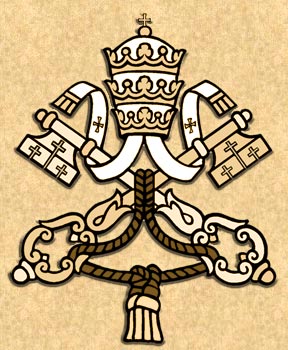Benedict XVI's choice of May 1 for the beatification of his predecessor is itself one of the richest symbols in today's celebrations.
This year's feast of Divine Mercy -- coinciding with the end of the Easter Octave -- lands today, since Easter was so late this year. And thus the feast falls on the first day of Mary's month.
On various occasions, Cardinal Joseph Ratzinger proposed that the fundamental element of Pope John Paul II's legacy in the Church is his understanding of Divine Mercy as the factor limiting human evil.
Celebrating the Polish Pope's funeral, Cardinal Ratzinger reflected that the Holy Father "interpreted for us the paschal mystery as a mystery of divine mercy. In his last book, he wrote: The limit imposed upon evil 'is ultimately Divine Mercy' (Memory and Identity, pp. 60-61). And reflecting on the assassination attempt, he said: 'In sacrificing himself for us all, Christ gave a new meaning to suffering, opening up a new dimension, a new order: the order of love ... It is this suffering which burns and consumes evil with the flame of love and draws forth even from sin a great flowering of good' (pp. 189-190)."
The cardinal added: "Divine Mercy: the Holy Father found the purest reflection of God’s mercy in the Mother of God. He, who at an early age had lost his own mother, loved his divine mother all the more. He heard the words of the crucified Lord as addressed personally to him: 'Behold your Mother.' And so he did as the beloved disciple did: 'he took her into his own home' (eis ta idia: Jn 19:27) – Totus tuus. And from the mother he learned to conform himself to Christ."
The mystery of evil
Karol Wojtyła suffered the two totalitarian regimes of the 20th century, Communism and Nazism, and asked how God could permit such terrible atrocities.
But while many would point to these evils to deny God's existence or negate his goodness, John Paul II used them to reflect on what God teaches by permitting man's free will to bring about tragedy. And he found an answer in Divine Mercy, as presented in the writings of the Polish mystic, St. Faustina Kowalska (1905-1938).
St. Augustine explains that God never causes evil, but permits it. In creating man with liberty, God accepted the existence of evil. Would it have been better for God not to create man? Or to create him without liberty? No. But then, the Polish youth who would one day take St. Peter's throne asked himself: What can limit evil so that it doesn't have the last word?
John Paul II understood that Divine Mercy is this limit to evil. His mercy does not imply that everyone is saved automatically, thereby negating sin, but rather that God pardons every sinner who allows himself to be pardoned.
And if pardon is the limit to evil (how many lessons could be taken from this truth to overcome war!), then liberty in a sense conditions Divine Mercy. God in some way took a great risk in creating man with freedom. He risked that his love would be rejected and that man would be able to negate the truth of his liberty and kill and abuse his brother. But in answer, God paid the most terrible price: the sacrifice of his only Son. We are the risk of God. But a risk that is overcome with the infinite power of Divine Mercy.
A posthumous message
John Paul II prepared a message for Divine Mercy Sunday of 2005, which he never delivered, since on the eve of the feast he was called to the Father's House.
The text was read at the end of the Mass celebrated that day for the repose of his soul.
"As a gift to humanity, which sometimes seems bewildered and overwhelmed by the power of evil, selfishness and fear, the Risen Lord offers his love that pardons, reconciles and reopens hearts to love. It is a love that converts hearts and gives peace. How much the world needs to understand and accept Divine Mercy," John Paul II had written.
Today's beatification ceremony began with a remembrance of the Polish Pontiff's devotion to God's Mercy. Thousands of pilgrims packed into St. Peter's Square and overflowing through the streets of Rome prayed the Chaplet of Divine Mercy, the devotion promoted by St. Faustina.
The image of Divine Mercy was displayed in front of the Basilica until the beatification Mass began.
Evil triumphs when good men do nothing - Edmund Burke
Sunday, May 1, 2011
Subscribe to:
Post Comments (Atom)









No comments:
Post a Comment